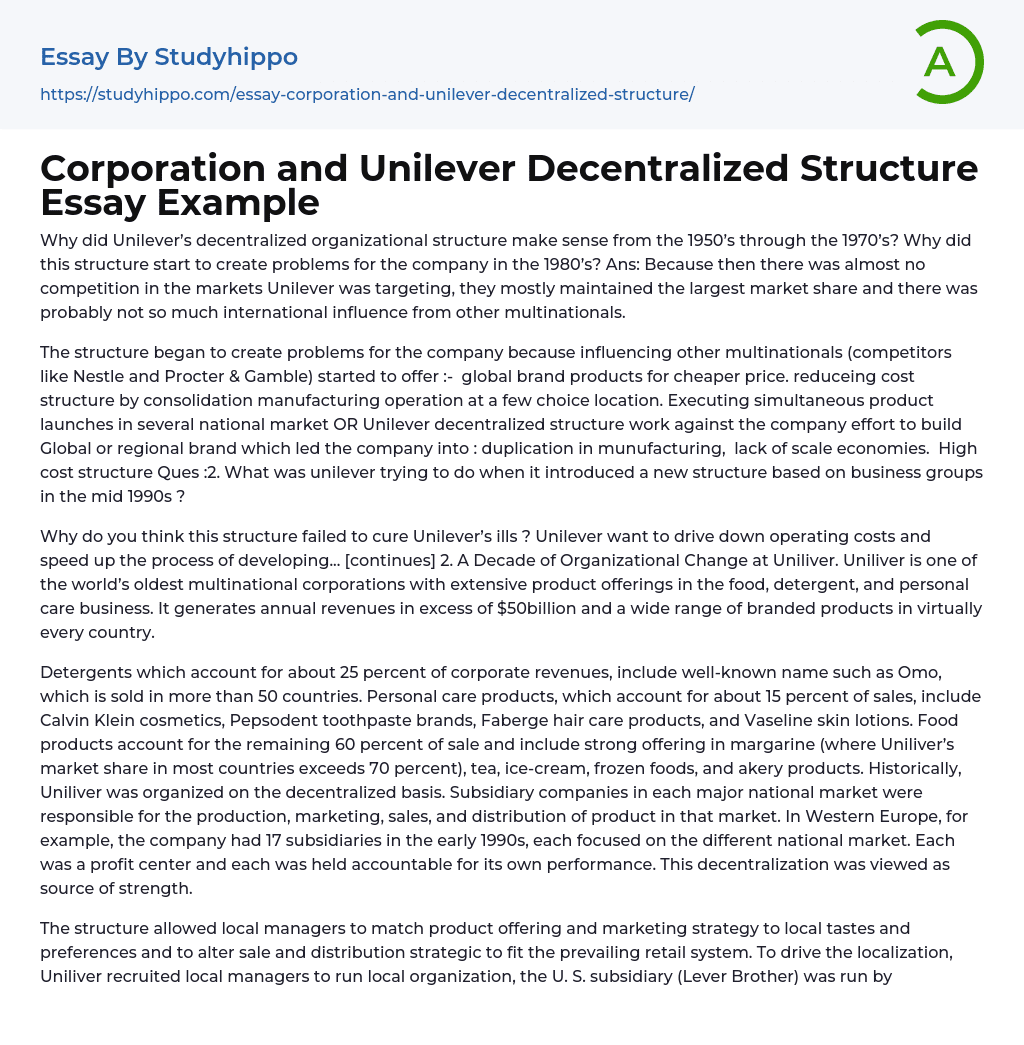

Corporation and Unilever Decentralized Structure Essay Example
Why did Unilever’s decentralized organizational structure make sense from the 1950’s through the 1970’s? Why did this structure start to create problems for the company in the 1980’s? Ans: Because then there was almost no competition in the markets Unilever was targeting, they mostly maintained the largest market share and there was probably not so much international influence from other multinationals.
The structure began to create problems for the company because influencing other multinationals (competitors like Nestle and Procter & Gamble) started to offer :- global brand products for cheaper price. reduceing cost structure by consolidation manufacturing operation at a few choice location. Executing simultaneous product launches in several national market OR Unilever decentralized structure work against the company effort to build Global or regional brand which led
...the company into : duplication in munufacturing, lack of scale economies. High cost structure Ques :2. What was unilever trying to do when it introduced a new structure based on business groups in the mid 1990s ?
Why do you think this structure failed to cure Unilever’s ills ? Unilever want to drive down operating costs and speed up the process of developing... [continues] 2. A Decade of Organizational Change at Uniliver. Uniliver is one of the world’s oldest multinational corporations with extensive product offerings in the food, detergent, and personal care business. It generates annual revenues in excess of $50billion and a wide range of branded products in virtually every country.
Detergents which account for about 25 percent of corporate revenues, include well-known name such as Omo, which is sold in more than 50 countries. Personal care products, which account fo
about 15 percent of sales, include Calvin Klein cosmetics, Pepsodent toothpaste brands, Faberge hair care products, and Vaseline skin lotions. Food products account for the remaining 60 percent of sale and include strong offering in margarine (where Uniliver’s market share in most countries exceeds 70 percent), tea, ice-cream, frozen foods, and akery products. Historically, Uniliver was organized on the decentralized basis. Subsidiary companies in each major national market were responsible for the production, marketing, sales, and distribution of product in that market. In Western Europe, for example, the company had 17 subsidiaries in the early 1990s, each focused on the different national market. Each was a profit center and each was held accountable for its own performance. This decentralization was viewed as source of strength.
The structure allowed local managers to match product offering and marketing strategy to local tastes and preferences and to alter sale and distribution strategic to fit the prevailing retail system. To drive the localization, Uniliver recruited local managers to run local organization, the U. S. subsidiary (Lever Brother) was run by Americans, the Indian subsidiary by Indian subsidiary by Indian and so on. By the mid-1990s, this decentralized structure was increasingly out of step with a rapidly changing competitive environment. Uniliver’s global competitors, which include the Swiss firm Nestle’ and Procter&Gamble from United States
- Company essays
- General Motors essays
- Bmw essays
- Ford Motor Company essays
- Honda essays
- Toyota essays
- Volkswagen essays
- Amazon essays
- Apple essays
- Enron essays
- Tesco essays
- Ibm essays
- Costco essays
- Kellogg essays
- Ikea essays
- Iphone essays
- Supermarket essays
- Gap essays
- Walmart essays
- Adidas essays
- Red Bull essays
- Pepsi essays
- Coca-Cola essays
- Burger King essays
- Kfc essays
- Mcdonald's essays
- Key essays
- British Airways essays
- Nokia essays
- Facebook essays
- Myspace essays
- Twitter essays
- Google essays
- Microsoft essays
- Ryanair essays
- Southwest Airlines essays
- Johnson and Johnson essays
- Sony essays
- Ebay essays
- Pepsico essays
- Starbucks essays
- Dell essays
- Intel essays
- Nestle essays
- Netflix essays
- Nike essays
- Samsung essays
- Bankruptcy essays
- Earnings essays
- Tata Group essays



